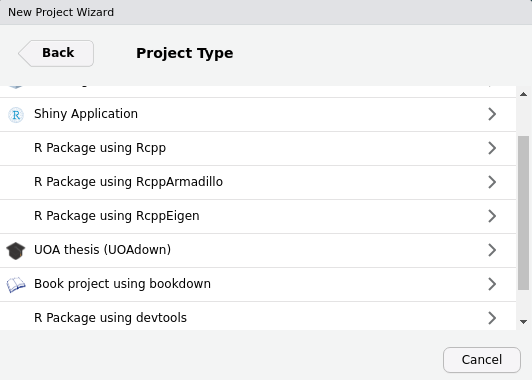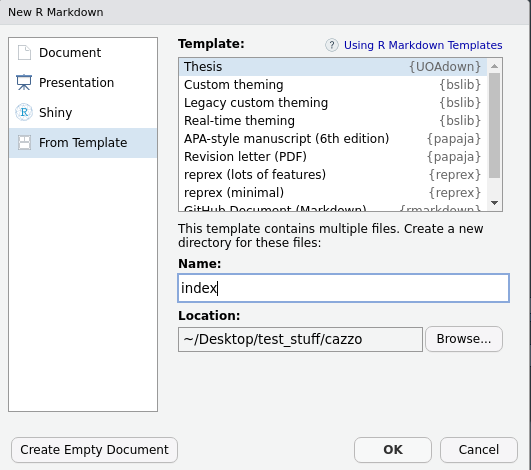Awesome
UOAdown
This project provides a template for the writing of theses and dissertations in R markdown, and it automatically renders them formatted according to the University of Auckland Guidelines. This project was inspired by the thesisdown package.
Currently, the PDF and gitbook versions are fully-functional. The word and epub versions are developmental, have no templates behind them, and are essentially calls to the appropriate functions in bookdown. If you really need them, open an issue or submit your template to be incorporated.
If you are new to working with bookdown/rmarkdown, read over
the documentation available in the UOAdown PDF template (automatically knitted
from the provided resources. Please, read below) or the bookdown
and the Rmarkdown books. Lots of other
resources are available online.
Under the hood, the University of Auckland LaTex template is used to ensure that documents conform precisely to submission standards. At the same time, composition and formatting can be done using lightweight markdown syntax, and R code and its output can be seamlessly included using rmarkdown.
NOTE: the template was created by the author and it respects the general guidelines linked above. These guidelines are not strict and might vary across departments. Thus, the APA style 7th guidelines have been implemented where the University did not provided rules. With time new citation styles might be added. Contributions on this are welcome.
Using UOAdown for your thesis
The following part largely comes from huskydown
Using {UOAdown} has some prerequisites which are described below. To compile PDF versions of your thesis, you need Pandoc and LaTex installed on your machine. Other packages might require installation (look at the output on your console when trying to use UOAdown).
The easiest way to get LaTex is with the tinytex R package:
install.packages(c('tinytex', 'rmarkdown'))
tinytex::install_tinytex()
# after restarting RStudio, confirm that you have LaTeX with
tinytex:::is_tinytex()
You may need to install a few extra LaTeX packages on your first attempt to knit as well. Here is one such example of how to do so:
tinytex::tlmgr_install("babel-portuges")
To use {UOAdown} from RStudio:
-
Ensure that you have already installed LaTeX and the fonts described above, and are using the latest version of RStudio. You can use
UOAdownwithout RStudio. For example, you can write the Rmd files in your favorite text editor (e.g. Atom, Notepad++). But RStudio is probably the easiest tool for writing both R code and text in your thesis. It also provides a nice way to build your thesis while editing. We’ll proceed assuming that you have decided to use the RStudio workflow. -
Install the {bookdown} and {UOAdown} packages
if (!require("remotes")) install.packages("remotes", repos = "https://cran.rstudio.org") remotes::install_github("rstudio/bookdown") remotes::install_github("d-scanzi/UOAdown")
Note that you may need to restart RStudio at this point for the following dialog to show up.
- Get started with the {UOAdown} template. There are two options for doing so.
-
3a) RECOMMENDED Create a new RStudio project with a {UOAdown} template.
In RStudio, click on File > New Project > New Directory. Then select Thesis Project using thesisdown from the dropdown that will look something like the image below. You’ll see the graduation cap as the icon on the left for the appropriate project type.

Next, give your project a name and specify where you’d like the files to appear. In the screenshot below, the project name is
my_thesisand it will appear as a new folder on my Desktop.
If for some reason this does not work, you can use the not recommended procedure described in the next step (3b). This procedure is not recommmended as it might have some limitation. Nonetheless, some testing did not show anything relevant.
-
3b) Use the New R Markdown dialog to select Thesis:

Note that this will currently only Knit if you name the directory
indexas shown above. This guarantees thatindex.htmlis generated correctly for the Gitbook version of the thesis.
- After choosing which type of output you’d like in the YAML at the
top of
index.Rmd, Knit theindex.Rmdfile to get the book in PDF or HTML formats.
Day-to-day writing of your thesis
You need to edit the individual chapter R Markdown files to write your
thesis. It’s recommended that you version control your thesis using
GitHub if possible. RStudio can also easily sync up with GitHub to make
the process easier. While writing, you should git commit your work
frequently, after every major activity on your thesis. For example,
every few paragraphs or section of text, and after major step of
analysis development. You should git push at the end of each work
session before you leave your computer or change tasks. For a gentle,
novice-friendly guide to getting starting with using Git with R and
RStudio, see https://happygitwithr.com/.
Rendering
To render your thesis into a PDF, open index.Rmd in RStudio and then
click the “knit” button. To change the output formats between PDF,
gitbook and Word, look at the output: field in index.Rmd and
comment-out the formats you don’t want.
The PDF file of your thesis will be deposited in the output_thesis directory,
by default. This directory will be created during the first knit process.
Components
The following components are ones you should edit to customize your thesis:
_bookdown.yml
This is the main configuration file for your thesis. You can change the name of your outputted file here for your thesis and other options about your thesis here.
index.Rmd
This file contains all the meta information that goes at the beginning
of your document. You’ll need to edit the top portion of this file (the
YAML) to put your name on the first page, the title of your thesis, etc.
Note that you need to have at least one chapter start in the index.Rmd
file for the build to work. For the template, this is done with
# Introduction in the example from the template.
`chapters
This is the folder where you need to save the chapters .Rmd files (see next point).
Having the chapters files all in the same directory should be cleaner.
01-chap1.Rmd, 02-chap2.Rmd, etc.
These are the Rmd files for each chapter in your dissertation. Write your thesis in these. If you’re writing in RStudio, you may find the wordcount addin useful for getting word counts and readability statistics in R Markdown documents.
bib/
Store your bibliography (as bibtex files) here. We recommend using the citr addin and Zotero to efficiently manage and insert citations.
csl/
Specific style files for bibliographies should be stored here. A good source for citation styles is https://github.com/citation-style-language/styles#readme.
The plan is to add more.
figure/ and data/
Store your figures and data here and reference them in your R Markdown files. See the bookdown book for details on cross-referencing items using R Markdown.
Running Head
The running head is required by the APA style guidelines. It consists of a shorter version of your title that will be presented in the header of each page. At the moment, the only way to change the running head is to do the following:
- Open the
UOAthesis.clsfile in R - Go to line 117 or look for "provisional: running head. You should see
the following lines:
\fancyhead[RE, RO]{ \MakeUppercase{Why ducks quack}} - Replace the default running head with what you want. Note, do NOT use quotation marks! Make sure the running head is short.
Margins
Margins are currently set according to APA style 7th guidelines for online publications (all margins set to 1in). If printing and binding is required, the template can easily be easily modified for this)
Publication pages
If some of the chapters are based on your published work, then you will need to add the Co-autorship form at the beginning of the relevant chapter. This form is not indexed (no page number and does not appear in the Table of Content). Thus, currently you need to add it after rendering the thesis, using a dedicated software (eg. pdfarranger on Linux or pdf24 creator for Windows or online).
The plan is to add the possibility to render those within the {UOAdown} package.